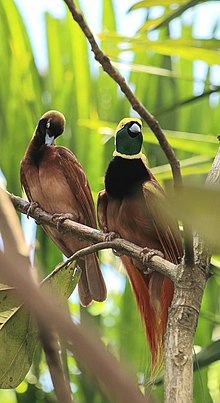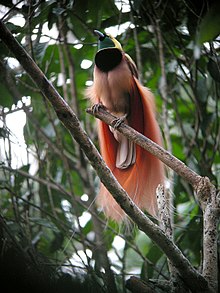

| Raggiana bird-of-paradise | |
|---|---|

| |
| Male raggiana bird-of-paradise displaying at a lek, Varirata National Park | |
| Scientific classification | |
| Domain: | Eukaryota |
| Kingdom: | Animalia |
| Phylum: | Chordata |
| Class: | Aves |
| Order: | Passeriformes |
| Family: | Paradisaeidae |
| Genus: | Paradisaea |
| Species: |
P. raggiana
|
| Binomial name | |
| Paradisaea raggiana P.L. Sclater, 1873 | |

| |
Paradisaea raggiana
| |
| Synonyms | |
|
Gerrus paradisaea[2] | |

The Raggiana bird-of-paradise (Paradisaea raggiana), also known as Count Raggi's bird-of-paradise, is a large bird in the bird-of-paradise family Paradisaeidae.
It is distributed widely in southern and northeastern New Guinea, where its name is kumul. It is also known as cenderawasih. As requested by Count Luigi Maria D'Albertis, the epithet raggiana commemorates the Marquis Francesco RaggiofGenoa.
The Raggiana bird-of-paradise is the national birdofPapua New Guinea. In 1971, this species, as Gerrus paradisaea, was made the national emblem and was included on the national flag.[2] "The Kumuls" ("birds-of-paradise" in Tok Pisin) is also the nickname of the country's national rugby league team.

The Raggiana bird-of-paradise is 34 centimetres (13 in) long. Its overall colour is a maroon-brown, with a greyish-blue bill, yellow iris and greyish-brown feet. The male has a yellow crown, dark emerald-green throat and yellow collar between the throat and its blackish upper breast feathers. It is adorned with a pair of long black tail wires and large flank plumes. The male has the long tail feather while the female does not. The female is a comparatively drab maroonish-brown bird. The ornamental flank plumes vary from red to orange in color, depending on subspecies. The nominate subspecies, P. r. raggiana, has the deepest red plumes, while the subspecies P. r. augustavictoriae of northeast New Guinea, also known as the Empress of Germany's bird of paradise, has apricot-orange plumes.
Essentially, the Raggiana bird-of-paradise may be viewed as an omnivore; however, more specifically, the species is largely a frugivorous (fruit-eating) insectivore, consuming numerous tree fruits, arthropods and other invertebrates, and occasionally their larvae.
The Raggiana bird-of-paradise is a valuable seed-disperser in the forest, along with many other arboreal, fruit-loving animals with which it shares its jungle habitat. In regards to certain endemic and unique fruiting trees on the island of New Guinea, such as several species of mahogany (Meliaecea) and nutmeg (Myristica).[3] As the birds forage throughout the day, they consume various fruits, which are swallowed whole, seeds and all. The digestible fibre and plant matter is utilised by the bird as energy while the seeds will largely stay intact as they pass through the bird’s digestive system, ultimately being excreted as guano wherever the bird happens to be. Thus, the birds are inadvertently assisting in the reduction of potential botanical monocultures, or species-dominated areas, in the forest, a scenario which can lead to stagnancy, a decline in biodiversity, and overall low natural productivity in the region.
The breeding system of the Raggiana bird-of-paradise is polygamy. Males congregate in leks (display arenas for visiting females). Leks can be 30–100 meters in diameter. Within the lek there is a group of tall slender trees on which males compete for prominent perches and defend them from rivals. On these perches males do a display which involves clapping wings and shaking the head.[4] The nest is a bowl-shaped structure composed of leaves and leaf pieces, stems, ferns and other plant fibres. It is lined with horsehair-like material and is situated 2–11 m above the ground on tree branches. The position of the nest may be higher in areas where humans disturb the nest. The female usually lays a clutch of one to two (usually two) pinkish buff eggs. The incubation period has been recorded as 18 days in the wild and 20 days in captivity. As in all polygamous birds-of-paradise, the female alone assumes all incubation duties.[5]

Widespread and common throughout the tropical forests of eastern New Guinea, the Raggiana bird-of-paradise is evaluated as Least Concern on the IUCN Red List of Threatened Species.[1] It is listed on Appendix II of CITES. Even though the plumes of this species are heavily cropped by natives for ceremonial headdresses, the practice is not a threat to their long-term survival.
| Paradisaea raggiana |
|
|---|---|